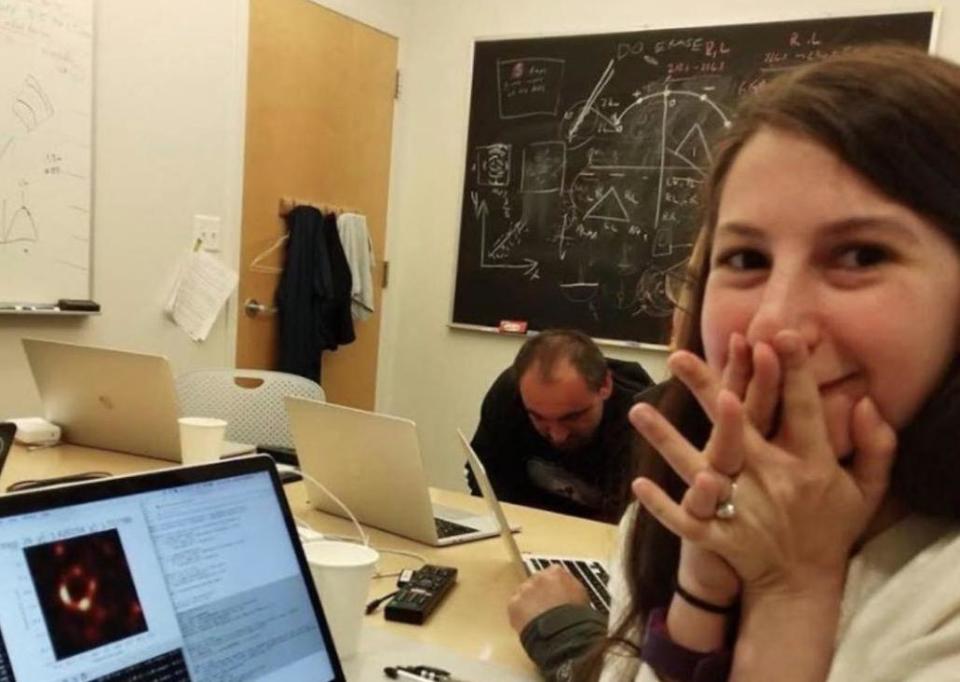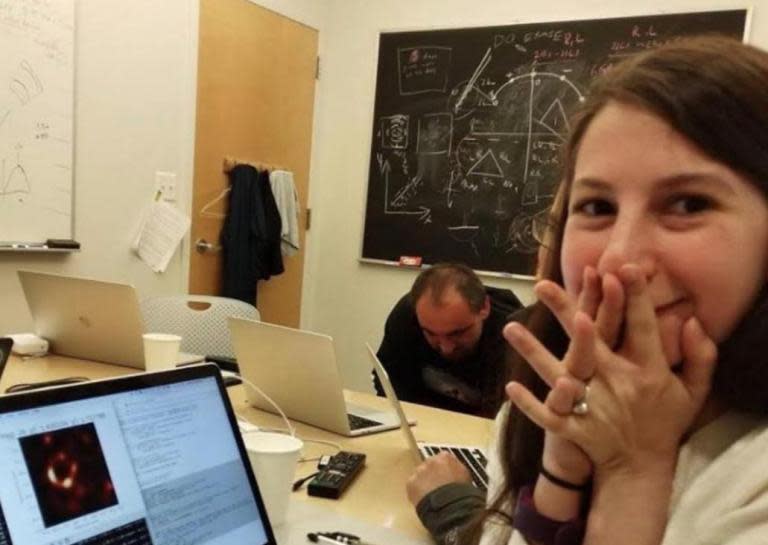Katie Bouman: Who is the scientist behind the first image of a black hole?
On Wednesday 10 April, the first image ever taken of a black hole was released.
The picture, which shows a black hole surrounded by a hazy red and yellow circle, provides an unprecedented peek at one of the most mysterious entities in the universe.
One of the scientists involved in the development of the picture is Dr Katie Bouman.
The scientist received worldwide attention when a photograph of her watching the black hole image being assembled went viral on social media.
So who is Dr Bouman, and how was she involved in capturing the first image of a black hole? Here's everything you need to know:
Who is Dr Bouman?
Dr Bouman is an imaging scientist, credited as being one of a team of scientists behind the development of the first image of a black hole at the heart of the Messier 87 galaxy.
The 29-year-old graduated from the University of Michigan in 2011 with a degree in electrical engineering.
The scientist later received her PhD at Massachusetts Institute of Technology (MIT), in electrical engineering and computer science.
What role did Dr Bouman play in capturing the picture of the black hole?
Three years ago, while still a graduate student at MIT, Dr Bouman led a project to develop a new algorithm that would lead to the construction of the black hole image.
The team of scientists that she led hailed from MIT's Computer Science and Artificial Intelligence Laboratory, the Harvard-Smithsonian Centre for Astrophysics and the MIT Haystack Observatory.
The new algorithm was dubbed CHIRP, which stands for Continuous High-resolution Image Reconstruction using Path priors.
When the development of the algorithm was announced in 2016, Dr Bouman compared photographing a black hole at the centre of the Milky Way galaxy to "taking an image of a grapefruit on the moon, but with a radio telescope".
In April 2017, the scientist delivered a TED talk in which she spoke about how to take a picture of black hole, a feat that had not yet been realised.
"Although we have some idea as to what a black hole might look like, we've never actually taken a picture of one before," Dr Bouman said during her speech.
"However, you might be surprised to know that that may soon change."
How did Dr Bouman and her team capture the picture of the black hole?
In order to capture the picture of the black hole, Dr Bouman and her team required a telescope the same size as Earth.
"Instead of building an Earth-sized telescope, which is obviously impossible, we took telescopes that were already built for other purposes and we merged them together into one computational telescope," Dr Bouman said.
These telescopes were synchronised using a technique called very-long-baseline interferometry.
Very-long-baseline interferometry is a technique used in radio astronomy which allows astronomers to see detailed images of the universe.
The scientists then conducted complex analysis of the data they garnered from the telescopes in order to produce the first image of the black hole.
Congratulations to Katie Bouman to whom we owe the first photograph of a black hole ever. Not seeing her name circulate nearly enough in the press.
Amazing work. And here’s to more women in science (getting their credit and being remembered in history) 💥🔥☄️ pic.twitter.com/wcPhB6E5qK— Tamy Emma Pepin (@TamyEmmaPepin)
When did the photograph of Dr Bouman with the picture of the black hole go viral?
On Wednesday, Dr Bouman shared a photograph of herself on Facebook revelling in the phenomenal achievement.
"Watching in disbelief as the first image I ever made of a black hole was in the process of being reconstructed," the scientist wrote on Facebook.
Dr Bouman also shared a photograph of the team of scientists whom she worked with to create the image.
"No one algorithm or person made this image," the scientist stated.
"It required the amazing talent of a team of scientists from around the globe and years of hard work to develop the instrument, data processing, imaging methods and analysis techniques that were necessary to pull off this seemingly impossible feat."
Dr Bouman added that it had been an "honour" to work with all involved.
How have people reacted to Dr Bouman and her team's achievement?
As can be expected, Dr Bouman and the team of scientists involved in the development of the picture of the black hole have been congratulated on their impressive feat.
“Take your rightful seat in history, Dr. Bouman!” tweeted US congresswoman Alexandria Ocasio-Cortez.
“Congratulations and thank you for your enormous contribution to the advancements of science and mankind. Here’s to #WomenInSTEM!”
"Haven't seen Katie Bouman's name enough today associated with the black hole photo," tweeted Yale history professor Joanna Freeman.
"She created a key algorithm that enabled this to happen -- as a grad student (!). A woman of science who deserves to have her name known."
Left: MIT computer scientist Katie Bouman w/stacks of hard drives of black hole image data.
Right: MIT computer scientist Margaret Hamilton w/the code she wrote that helped put a man on the moon.
(image credit @floragraham)#EHTblackhole #BlackHoleDay #BlackHole pic.twitter.com/Iv5PIc8IYd— MIT CSAIL (@MIT_CSAIL)
In a tweet shared by the MIT Computer Science and Artificial Intelligence Lab, a photograph of Dr Bouman with hard drives containing black hole image data is placed alongside a photograph of computer scientist Margaret Hamilton.
"My daughter has a Lego set with Margaret Hamilton. Time for a second series to include Katie Bouman!" one person tweeted in response.
For all the latest on the black hole photograph, click here.
For all the latest tech news, click here.



